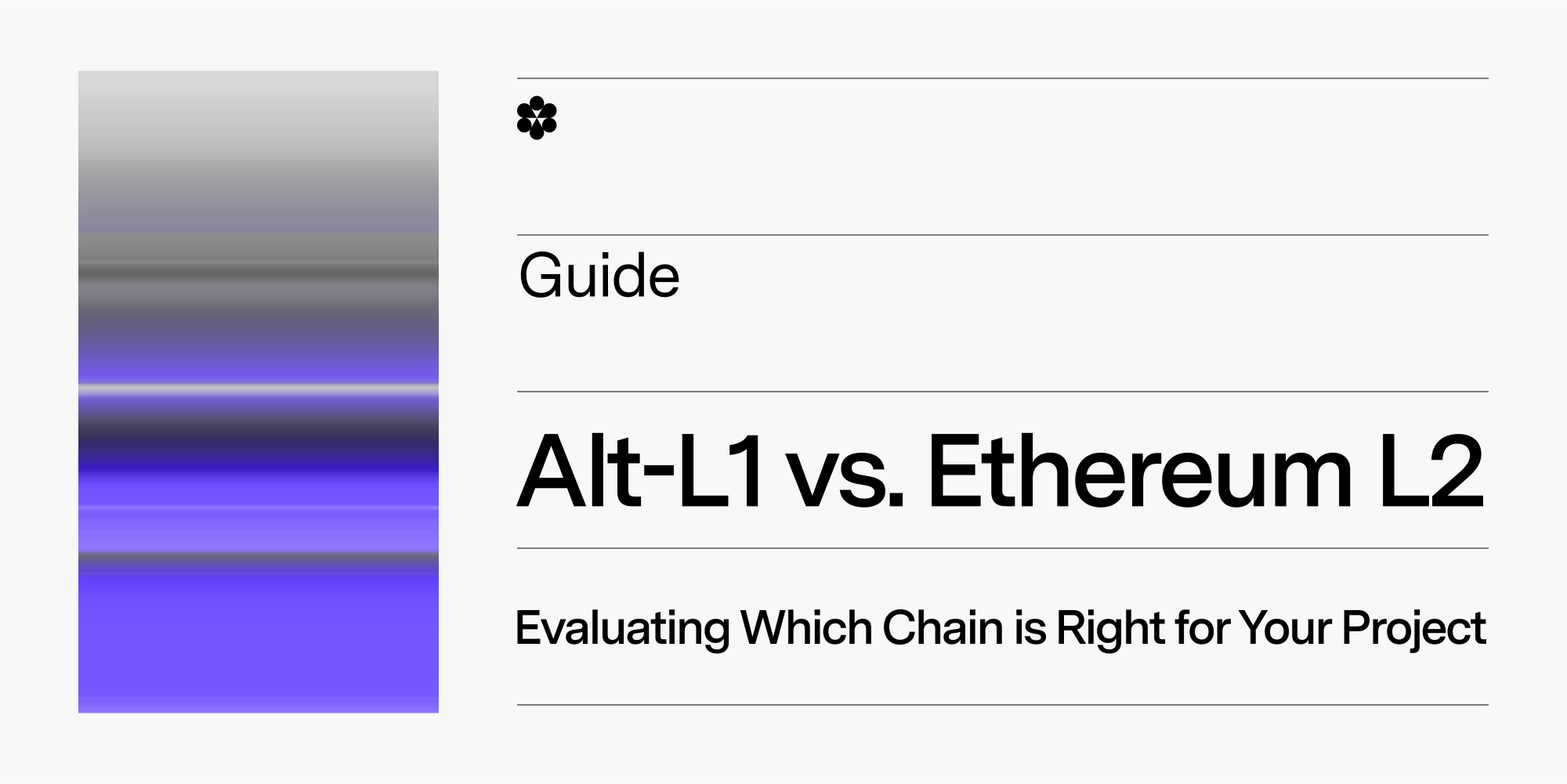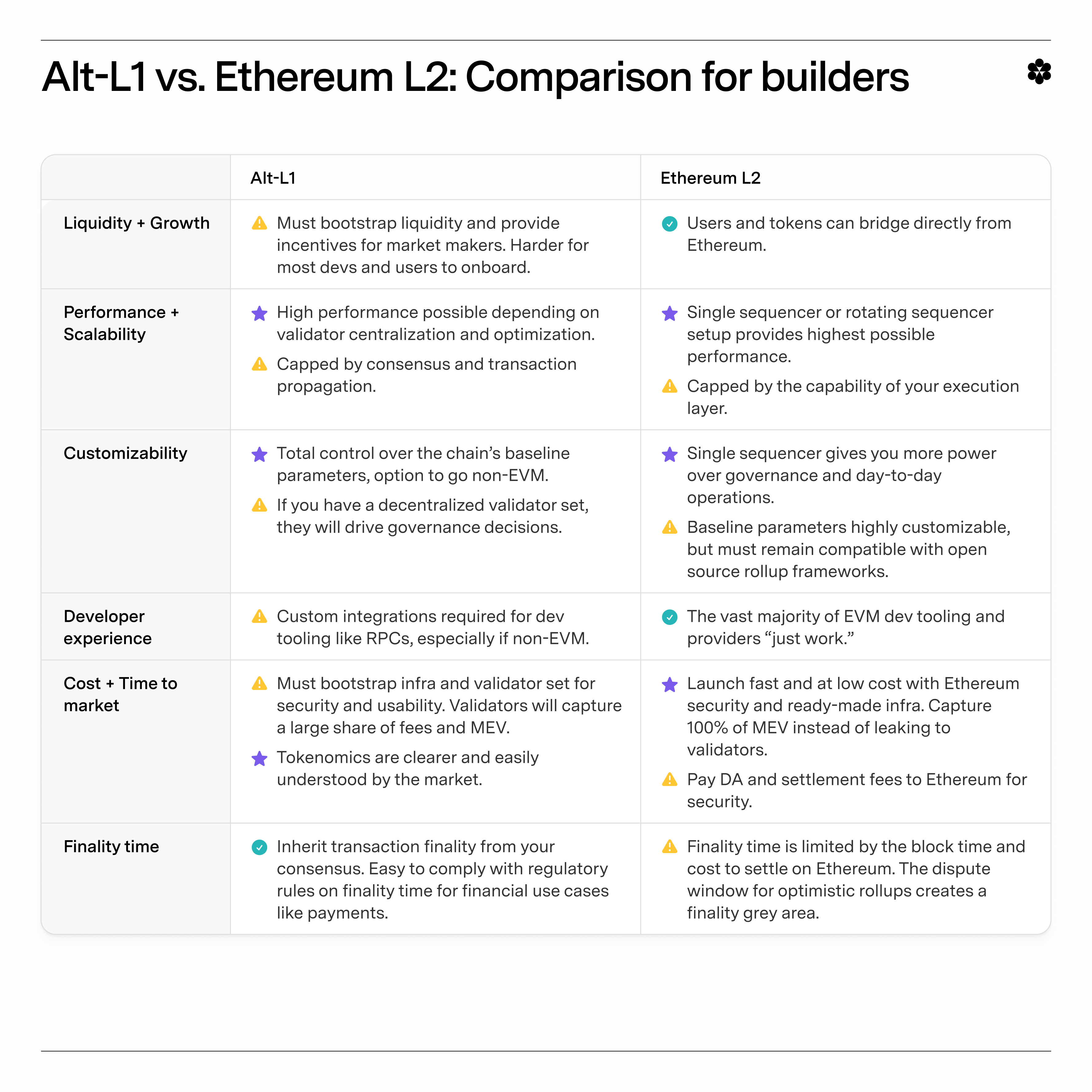Alt-L1 vs. Ethereum L2: Evaluating Which Chain is Right for Your Project
If you're building your own chain, you'll face a crucial question: Alt-L1 or Ethereum L2? We break down the pros and cons of each here, and tell you how to evaluate for your project.

Major firms from both web3 and web2 are launching their own dedicated chains. Whether you’re building to support one app, an entire ecosystem, or taking a hybrid “product-led protocol” approach, the benefits are clear: Better economics, stronger performance, and more customization for your exact use case.
But if you want to build your own chain, you’ll face a crucial question: Should you build an alternative Layer 1 chain (alt-L1) or a Layer 2 on Ethereum (L2, or rollup)? [1]
There are examples of leading projects for both. Robinhood recently announced that it will launch its chain as a rollup built with Arbitrum Orbit. Coinbase did the same with Base chain, but used the OP Stack. On the other hand, Hyperliquid has achieved huge success launching its DEX as an alt-L1, while Stripe and Circle have revealed plans to launch their own L1s.
There’s no single right answer. Each approach offers distinct trade-offs, and you need to identify which chain strategy fits best with your priorities and long-term vision. At Conduit, we’ve helped several teams manage this decision, and will share our learnings here. Keep reading to learn about the key differences between alt-L1s and Ethereum L2s, and how to evaluate the right path for your project.
Alt-L1 vs. Ethereum L2: Comparison cheat sheet

Alt-L1: Pros and cons
Alt-L1s have huge potential for many projects, but developers need to understand the trade-offs involved. Despite prevailing narratives, alt-L1s aren’t an automatic shortcut to superior performance or total customizability. As an L1, your validator set will determine the upper bounds of both performance and customizability, and also take a significant share of your chain’s fee and MEV revenue.
Benefits of an alt-L1
1. Customizability
Alt-L1 builders get full control of their chain’s foundational parameters, such as the consensus and governance models. You can tailor attributes like block times, validator requirements, and consensus algorithms to your project’s unique needs.
On an alt-L1, you can also choose whether or not to build on the Ethereum Virtual Machine (EVM) – a crucial decision. Non-EVM environments like Solana Virtual Machine (SVM) support popular languages such as Rust for smart contract development (also possible for some rollups using tools like Arbitrum Stylus), and are arguably better for parallel processing and onchain performance. Of course, you can also stick with the EVM for Solidity’s proven tooling and developer ecosystem, but keep in mind you won’t get the same level of compatibility with many infra pieces (RPC nodes, block explorers, etc.) that you would with EVM on an L2.
2. High performance potential (with caveats)
Alt-L1s can hit impressive performance – up to tens of thousands of TPS and sub-second latency – but with a few trade-offs. Optimal performance often depends on a tightly centralized validator set and strategies like colocation, which negatively impacts the chain’s security guarantees and censorship resistance. On the other hand, a more decentralized validator set can lead to performance limitations from consensus overhead – the greater the number of validators and the more spread out they are, the longer it takes them to validate new transactions.
Of course, the beauty of the alt-L1 is that you can think about whether to prioritize decentralization or performance in advance, and build the right validator setup for your use case.
3. Clear, intuitive tokenomics
Tokenomics are straightforward for alt-L1s: Validators receive payment directly in the chain’s native token, just like on Ethereum. That simplicity is easy for the market to understand, whereas many Ethereum L2s have to actively build and communicate new forms of token utility.
4. Transparent, regulator-friendly definition of finality
Transaction finality on alt-L1s is clear and easy to understand, as it’s explicitly tied to validator consensus. That’s important from a regulatory standpoint, as many jurisdictions have rules on finality timing and predictability for various financial businesses. For instance, the EU mandates that payment providers meet a 10-second finality standard – developers can easily configure their alt-L1 to meet that.
- Credible neutrality
L1s running on dedicated validator sets are generally perceived as more credibly neutral than L2s running on the single-sequencer model. This is important for many business models, especially those challenging traditional financial institutions, who value the neutrality of the infrastructure they use to conduct transactions.
Downsides of Choosing an Alt-L1
1. Liquidity and growth challenges
It can be harder for alt-L1s to attract initial liquidity and users, as they don’t have ready-made native bridges to bigger, more established chains. That means alt-L1s often need to bootstrap liquidity by offering token incentives to market makers and bridges, which can be expensive. The lack of existing bridges, as well as the comparative trust gap with a new chain, also makes it harder to onboard users. Ethereum L2s on the other hand have a huge pool of users who can move assets to their chain more easily and with trusted bridges.
2. Engineering burden and launch time
Integrating essential tooling such as RPC node providers, block explorers, indexers, and the like is typically more complex and resource-intensive for alt-L1s, as most tools are designed for the Ethereum ecosystem. Even platforms and providers that support alt-L1s will likely provide fewer integration options and require bespoke implementations, adding more overhead and making it harder to launch quickly. Infrastructure will also likely be more expensive.
Even after launch, most alt-L1s will face a higher engineering burden, especially if they want to maintain compatibility with Ethereum. When Ethereum ships important new upgrades, such as the EIPs for account abstraction, L2s can easily opt into them via their rollup frameworks. Alt-L1s will need their engineers to manually implement these upgrades end to end – testing, auditing, deploying, etc. – which creates an ongoing engineering cost.
3. Higher costs
As we mentioned above, attracting liquidity and building out bespoke infrastructure adds to the costs of running an alt-L1. Validators also add significant costs.
Case in point: Celo recently switched from L1 to L2, and its security costs dropped from $6.9 million per year to just $13,200 – a 99.8% drop, as they no longer have to pay validators.
The craziest part is that this move saved their chain millions, as they no longer have to pay validators as much for securing the network.
— Lorenz Lehmann (@LehmannLorenz) August 12, 2025
Full analysis by @web3_data here: https://t.co/cYiOcigOZy pic.twitter.com/cdjqXDnhdF
Validators capture a large share of transaction fees and MEV throughout the chain’s lifetime – fees that could be fueling your ecosystem growth and product development. And those are just the ongoing costs. There are up front costs too, as alt-L1s often must provide incentives to attract validators if they want a robust, decentralized set.
4. Developer experience friction
Alt-L1s, especially those running non-EVM execution environments, face developer experience hurdles, as tooling options and documentation are generally less robust than what’s available in the EVM world.
Ethereum L2: Pros and Cons
L2s have quickly gained momentum thanks to their compelling mix of Ethereum-grade security, strong liquidity, developer-friendly tooling, and rapid deployment timelines. But, as with alt-L1 chains, Ethereum L2s have pros and cons that impact whether one is right for your project.
Benefits of Ethereum L2
1. Ethereum ecosystem access spurs growth
Launching an L2 immediately connects your project to Ethereum’s expansive ecosystem, including vast liquidity across ETH, stablecoins, and the most popular DeFi tokens, as well as a massive user base. Users can effortlessly bridge assets over from Ethereum mainnet, giving your chain instant credibility and reducing onboarding friction.
2. Superior tooling and developer experience
Ethereum rollups offer near-complete compatibility with Ethereum-native developer tooling:
- Established developer tooling (e.g. Solidity)
- Mature infrastructure providers, e.g. rollup platforms like Conduit, wallet infra providers like Privy, developer platforms like thirdweb, etc.)
- Integrations that “just work,” with less friction than custom implementations and tooling required for alt-L1s
Plus, since Ethereum is the hub of blockchain development, there are many more organizations pushing forward on new innovations your chain can benefit from – teams like Optimism, Arbitrum, Flashbots, and more. Most alt-L1 stacks on the other hand have just one core team focused on their development.
3. Ultra high performance
Ethereum L2s typically utilize a single sequencer setup, enabling higher throughput, faster confirmations, and lower latency than an alt-L1 with a decentralized validator set can achieve. While the sequencer itself is centralized, Ethereum’s robust underlying security and decentralization provide assurances on censorship resistance and asset safety.
4. Lower costs, less overhead, faster launches
Ethereum rollups significantly lower your operational overhead and accelerate time-to-launch:
- No need to independently bootstrap liquidity, validators, or build out extensive custom infrastructure.
- Reduced operational complexity during setup and ongoing maintenance thanks to well-established, managed infrastructure providers.
- Minimal validator-related setup or costs (main expense being Ethereum’s data availability fees), allowing more economic value to stay within your project.
If you’re optimizing for time-to-launch and the lowest possible costs, an Ethereum L2 is the clear winner.
Downsides of Ethereum L2
1. Performance and costs impacted by Ethereum mainnet
Throughput ceilings for Ethereum L2s are constrained by Ethereum’s mainnet performance capabilities and data availability bandwidth. Ethereum sets an upper bound on how much transaction data can be processed at any given time, and its congestion and fee levels impact your DA costs. However, Ethereum’s performance across those variables is constantly improving.
2. Limits on customizability and governance models
While you can customize your rollup significantly, its baseline parameters must remain compatible with the open source frameworks you use, like Arbitrum Orbit and OP Stack. These tools restrict certain consensus and fee models at a technical level, as can broader Ethereum community dynamics.
3. Less intuitive token utility
Because Ethereum mainnet provides security, rollups must clearly define and justify their token’s utility – they don’t have the easy model of validator incentives. This can require creative configurations and unique staking setups – such as implementing the project’s native token as a custom gas token – but those can be harder to build and communicate to the market.
4. Finality complexity
Rollup transaction finality relies on Ethereum’s mainnet settlement time (12 minutes). Optimistic rollups further complicate finality timelines due to the seven-day dispute window. This extended timeline can create regulatory complexities, particularly for payment-focused applications.
Checklist: Should your project be an alt-L1 or Ethereum L2?
Below, we provide a checklist to help determine if your project’s priorities better align with an alt-L1 or Ethereum L2. Keep in mind, this checklist isn’t prescriptive – many of these priorities are achievable under both frameworks, but take more work on one versus the other. It’s also important to remember that onchain infrastructure is constantly evolving, and what may be difficult or infeasible under one chain strategy today could be easy tomorrow.
When an alt-L1 may be a better fit:
- You want full control over parameters like consensus model, gas token economics, and execution environment.
- You can fund and sustain a validator set and are prepared to share transaction fees and MEV with them.
- You want clear, intuitive token utility tied directly to validator rewards.
- You need transparent, deterministic finality for regulatory or operational reasons.
- You want the freedom to optimize for extreme performance and are willing to trade decentralization to get there.
- You have a strategy and budget to bootstrap liquidity and infrastructure from scratch or with partners.
When an Ethereum L2 may be a better fit:
- You want to launch quickly without bootstrapping validators, liquidity networks, or custom infrastructure.
- You're migrating an existing EVM app to its own chain.
- You want instant access to Ethereum’s liquidity and user base via native bridging.
- You want to leverage Ethereum’s mature developer tooling with minimal integration overhead.
- You need high performance with low operational complexity.
- You want to own 100% of chain revenue, without leaking fees and MEV to validators.
Choose the right chain strategy for your project
Whether you choose an Alt-L1 or an Ethereum L2, the decision comes down to aligning your chain’s architecture with your project’s goals, resources, and long-term vision. Each path offers unique strengths and trade-offs around performance, customization, decentralization, growth potential, and more – there’s a lot to consider.
Luckily, Conduit can help you navigate this decision with clarity and speed. Our team has deep, hands-on experience with both Ethereum L2s and alt-L1s, so we know the technical, economic, and operational realities of each path. We work with you to evaluate your priorities, design the right architecture, and launch with the infrastructure, integrations, and performance you need to succeed from day one.
Book a consultation with Conduit to cut through the complexity and launch the right chain for your needs. We have the infrastructure, integrations, and expertise to get it right from day one.
[1] L3s are another option – for the purposes of this comparison, just group them in with L2s.

